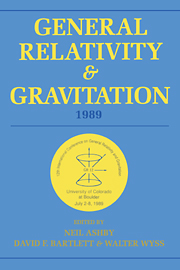 General Relativity and Gravitation, 1989
General Relativity and Gravitation, 1989 Published online by Cambridge University Press: 05 March 2012
The theory of imaging of cosmologically distant point and extended sources, specifically quasars and galaxies by an intervening mass is described. Particular attention is paid to formalisms which allow one to understand the qualitative principles governing image formation. The importance of caustics is emphasized, particularly their role in the formation of highly magnified images. The prospects for measuring the Hubble constant and the cosmological density parameter are reviewed.
Introduction
The history of gravitational lensing is one in which general relativists can take some pride. The basic effect was anticipated by many researchers including Einstein (1936); Refsdal (1964); Press and Gunn (1973); Bour-rassa and Kantowski (1975); long before the discovery by Walsh, Car-swell and Weymann (1981) of the first convincing example of multiple imaging of a background quasar by an intervening galaxy. This is perhaps not too surprising since gravitational lensing is an almost trivial consequence of the general theory. What was surprising was how rich a field the elementary geometrical optics of gravitational lensing has become when stimulated by the observational discoveries reviewed here by Bernard Fort (Chapter 6, this volume). I intend to review some of the theoretical approaches to gravitational lenses that have been developed over the past ten years emphasizing those that are directly relevant to interpreting the observations.
Gravitational lenses have been heralded as important astronomical tools; specifically they are probes of the dark matter found in the outer parts of galaxies, rich clusters of galaxies and perhaps also the universe at large.
To save this book to your Kindle, first ensure [email protected] is added to your Approved Personal Document E-mail List under your Personal Document Settings on the Manage Your Content and Devices page of your Amazon account. Then enter the ‘name’ part of your Kindle email address below. Find out more about saving to your Kindle.
Note you can select to save to either the @free.kindle.com or @kindle.com variations. ‘@free.kindle.com’ emails are free but can only be saved to your device when it is connected to wi-fi. ‘@kindle.com’ emails can be delivered even when you are not connected to wi-fi, but note that service fees apply.
Find out more about the Kindle Personal Document Service.
To save content items to your account, please confirm that you agree to abide by our usage policies. If this is the first time you use this feature, you will be asked to authorise Cambridge Core to connect with your account. Find out more about saving content to Dropbox.
To save content items to your account, please confirm that you agree to abide by our usage policies. If this is the first time you use this feature, you will be asked to authorise Cambridge Core to connect with your account. Find out more about saving content to Google Drive.